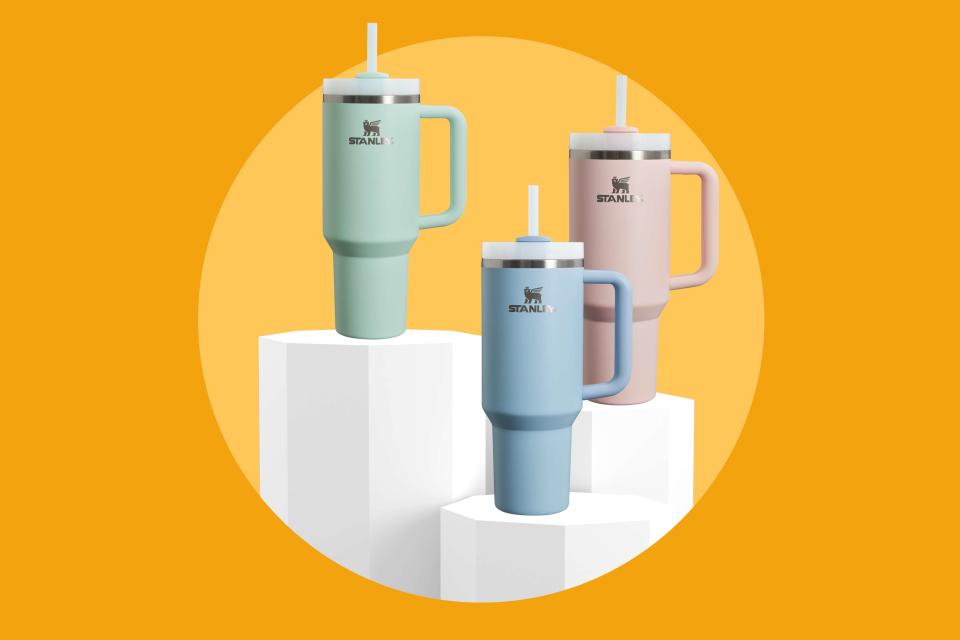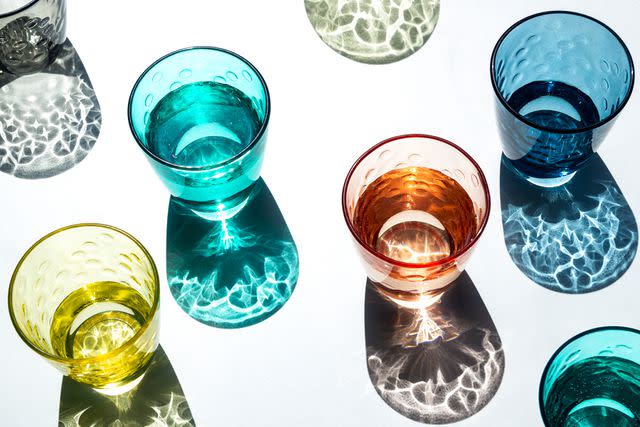There Is Something Primal About Our Love for Cups
The current Stanley cup frenzy is just history repeating itself, according to a classics scholar.

Stanley / Getty Images
The fights that break out over limited-edition Starbucks and Stanley collaboration tumblers make headline news, as do the lines that snake out of Target stores when new inventory is dropped. The exorbitant prices these items fetch on eBay, far above retail prices, also make the news. Scroll through TikTok and no matter how personalized your For You page is, chances are, a video of someone decorating their Stanley with accessories as if it were a Barbie will probably sneak into your feed.
There are people out there who lug their Stanleys everywhere — and truly, they have to be lugged. I surreptitiously picked up a full Stanley tumbler belonging to a child at a friend’s house. It was very heavy. It could be used as a weapon, inflicting surefire blunt force trauma. Surely kids are pulling shoulder muscles when succumbing to this fad?
TikTok trends ebb and flow, frothing like waves, working up until oversaturation overtakes frenzy, then slipping away and making way for the next big thing. YETI, Hydroflask, and of course, Stanley, have been serial obsessions whose swells have crested and spilled over from the realm of TikTok teenagers into our wider cultural consciousness. If you’ve paid any attention to the internet in the last few years, these names probably stir up strong feelings of passion and befuddlement.
Related: We Tested the Stanley Quencher Against the Yeti Rambler — This Is What We Found
“Why are people obsessed with the Stanley tumbler?” I ask my friend Megan, who is thoroughly American, and my go-to translator of American pop culture.
“Because the internet told them to be,” she replied.
OK, but there’s got to be something else here. What do all these objects, from Stanley to YETI to Hydroflask all have in common? Well, they’re all drinking vessels.
For the longest time, I belonged to the befuddlement camp, unable to muster up the enthusiasm to make any cup my personality, or impose my personality onto a cup, whether through silicone covers, specialty straps, tiny straw covers, a name tag, snack trays that affix to cup lids, or even purchasing one of these vessels. (I do own a YETI. I like it a lot. It was bestowed upon me, for free, after my participation in a conference.)
Related: My Go-To Stanley Cup Isn't the Viral Tumbler, and Shoppers Agree That It’s 'Highly Underrated'
But in my quest to understand the hold that drinking vessels have on wide swaths of our population, I have left Camp Befuddlement. I get it now. Truly. I’m not saying go and punch someone in the head to pay too much money for a pink cup next time you’re at Target, but let’s take a minute and meditate on why some people do.

Getty Images
In 2014, the Meiyintang “Chicken Cup” from the Ming Dynasty sold at auction for $36 million, smashing all previous cup records. When we bestow an honor upon a winner, chances are, it takes the form of a cup. There’s that other Stanley Cup, the one you get when you play really good hockey. There’s the World Cup, which renders nations berserk every four years. And don’t even get me started on the Holy Grail. All these cups channel status, worth, and legacy into, well, a cup. Humans are a cup-centric species. We determine our outlook on life according to whether a cup is half full or half empty.
"We determine our outlook on life according to whether a cup is half full or half empty. "
Kiki Aranita
Once upon a time, I was a baby. My parents took me on walks, as one does with babies, to the Brooklyn Heights Promenade. My absolute favorite activity as a baby was to take my baby bottle and fling it through the railing onto the trucks rumbling down the Brooklyn Queens Expressway below. It was glorious. It infuriated my parents, who had to purchase far too many bottles for one baby. My habit ceased when they gave me a luminous pink bottle, shaped like an elongated, oval donut. I adored this bottle. I never wanted it out of my grasp. This bottle defined my very existence. It was an extension of my hand which grasped it through its donut hole. I inexplicably miss this pink bottle to this day, as it has been lost to the ages, and not the BQE.
Related: I Think Stanley Tumblers Are Overrated—You Need This Water Bottle Instead
There’s something so primal about loving a drinking vessel, so I ask my grad school friend Mel who has a baby, is a teacher, and also, has a PhD in Classical Studies, if the current Stanley tumbler craze makes any sense to her.
“I don’t get it,” she says, bemoaning her middle school students’ fixation with their cups.
I try a different tactic. “Okay, Mel, but you and I – we’ve spent years of our lives studying cups. We go to museums across the world and look at cups. We even study tiny pieces of cups, too small to be called ‘shards,’ they’re ‘sherds.’”
“These cups aren’t museum worthy!” she says flatly.
“But they might be in 2000 years!”
Related: The 9 Best Travel Coffee Mugs, Tested and Reviewed
A common TikTok video trope has been someone proudly displaying their walls adorned with special shelves to hold a veritable rainbow of Stanley cups. Far more than ever could be needed to keep yourself hydrated, and stirring up commentary on how this practice negates the environmental friendliness of using a tumbler to avoid disposable cups. But just as humans are a cup-fixated species, we are also a collecting species.
"Just as humans are a cup-fixated species, we are also a collecting species. "
Kiki Aranita
My friend Megan, who flippantly said the Stanley mania was borne simply out of the internet, collects tiny salt and pepper shakers. My editor who assigned me this article, I suspect, did so as a tangential way to brag about her childhood Breyer horse collection. (Editor's note: I've moved on to household objects shaped like food.) I also collect things: amulets and charms that supposedly ward off evil, tiny souvenirs from temples and churches around the world, emblems of beliefs that I don’t ascribe to. Mercifully, my collection can fit in the palm of my hand and does not require redecorating my living room to resemble a Thermos showroom.
I am fascinated by other people’s collections, even if I have no desire for any of those things. In a section entitled “Why We Collect” in Dr. Shirley M. Mueller's Inside the Head of a Collector: Neuropsychological Forces at Play, the author explains, “The reason we collect is simple. It makes us happy. In this faraway place, apart from the rest of our lives, we can imagine. This is different than when we are involved in the routine aspects of living; then, we can reliably predict much of what will happen.” She goes on to describe how collecting as a passion leads the collector down pathways of chance and excitement that even she has experienced.
Related: The Best Glass Water Bottles and Tumblers to Use Every Day
To watch collecting morph into hoarding adds another layer of fascination; humans are also a voyeuristic species. Acquiring a Stanley cup in every single color is probably as irrational and unsustainable as hoarding, and maybe less fascinating than collecting Breyer horses, but it leads me to my next point, which is that watching hoarding and unfathomable collecting is its own inescapable impulse.
Watching the show Hoarders, I witness a path of thinking alien to my own and specific to the hoarder. I watch Hoarders with the same fascination, derision, and confusion as I do videos posted by cup collecting TikTokers, with their specially built cup display shelves. I experience catharsis in watching the lives of people in catastrophic piles of stuff, as they resist help and sink into further despair before their houses are cleared out. Dr. Robin Zasio’s soothing voice, with which she gently coaxes hoarders through their struggles and seeks the specific psychological roots of their condition, is a balm for my own soul, even before the families intervene, mental health resources are found, and houses cleaned up.
Related: Loved That Meal? Take Home a Menu Memento
I spent about as much time in grad school studying catharsis as studying cups. Though the meaning of catharsis has evolved over millennia, Aristotle used the term, meaning “purification” to describe how watching Greek tragedy arouses pity and fear in an audience, causing them to feel relief. Which is probably why TikToks of Stanley cup collectors are so compelling. Those of us who do not ascribe to these practices watch them, may feel pity and fear, and then relief, which carries into their own lives.
We watch the frenzy over Stanley devotees’ discovery that its base contains lead (though many things do and so long as you don’t gnaw on the base of your tumbler, you’re fine), and once again every major news outlet from the New York Times to the BBC is covering cup news, just as we thought the topic was waning. Another piece of news wherein people felt pity (for those who had acquired so many cups), fear (there’s lead where?), and then relief (we’re all safe).
I text my friend Mel, “Well, lead is another thing Stanley cups have in common with ancient cups.” She responds with a laughing emoji, a modern hieroglyph — which we also studied in grad school.
May your Stanley cup runneth over with peace, love, and catharsis.
For more Food & Wine news, make sure to sign up for our newsletter!
Read the original article on Food & Wine.

